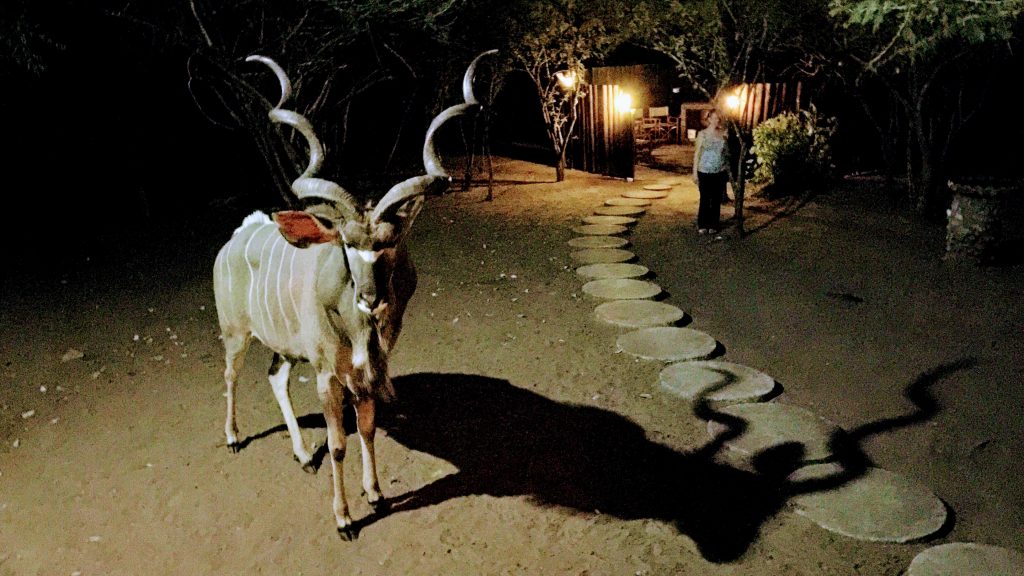Deprecated: Function get_page_by_title is deprecated since version 6.2.0! Use WP_Query instead. in /homepages/42/d513373005/htdocs/wp-includes/functions.php on line 6085
Deprecated: Function get_page_by_title is deprecated since version 6.2.0! Use WP_Query instead. in /homepages/42/d513373005/htdocs/wp-includes/functions.php on line 6085
Our trip drive down from the Satara Rest Camp took us through the Eastern Kruger, paralleling Mozambique, about 5 miles (8 km) away. I really wanted to visit Mozambique, but we couldn’t make it happen :-/
One of the major things we see is an elephant rubbing on a tree. From A Game Ranger’s Note Book by Arthur Blayney Percival, 1927:
“Rubbing trees” are often found near the elephant roads — it may be a few paces on one side or the other — and both ground and bark show that these are frequently visited. Such trees are seen wherever elephants occur. They are very common near water, and the mod-holes in which the animals love to wallow, for, having covered themselves with mud, they come out and seek the nearest suitable tree, where they rub off as much as they conveniently can; and, as the same tree is used regularly, the bark may be entirely rubbed off. Such trees often are found at considerable distances from either water or mud, a fact whcih seems to indicate that removal of mud is not the sole reason for rubbing…
This habit is not peculiar to the elephant; many other beasts do the same thing. Any big stone on the plains is sure to be well polished by the rhinoceros, and if it, or part of it, is not too high above the ground, a foot or thereabouts, the top will be beautifully smoothed by the rhino, who enjoy rubbing their bellies. Wart hog polish the lower sides of such stones in the same way.
Modern African elephant conservation is a complex thing, balancing an endangered population against the damage such large animals cause. Elephants kill trees like ancient baobabs, knobthorns — where birds of prey often make their nests — and marulas by uprooting, debarking, and breaking branches (making them susceptible to fire and infestation by wood-boring insects). Rare plants, such as the lalla palm, also are damaged. This reduces the habitat available for other wildlife species. Elephants can eliminate entire communities of these trees in a very short amount of time. According to aerial surveys, large trees are declining by about 45 per cent in observed areas. [source: panda.org]
We couldn’t pull ourselves away from this idyll, zebra and several deer species.
A lioness, hunting.
Needles Lodge / 341 Bushpig Ave, Marloth Park, 1320, South Africa / +27 79 190 9805
Needles Lodge will always in my mind as the place where we were greeted by wart hogs.
Needles Lodge is located in a a rural, almost suburban, neighborhood just south of Kruger. After all the safari lodges we’ve seen thus far, all located on huge tracts of land, it’s decidedly strange to look through the trees and see other houses.
Our room is small but comfortable, with rough whitewashed walls and a wood Randoval-like ceiling. A spinning fan pushes the air around, making the warm air much less troubling. There’s a small sofa and a smaller writing desk.
The bathroom has a big shower and an exposed bathtub with terra cotta tiles around the base. It’s a very inviting bath, perfect after a day of walking about.
We chose to have meals prepared by the lodge as part of our package. What a great idea: the local kitchen staff had mouth-watering smells wafting around the place almost as soon as we arrived. The food that arrived shortly thereafter was delicious and plentiful.
The wooden napkin-holders, carved to look like giraffes, are emblematic of the thoughtfulness the Needles Lodge staff brought to all aspects of the meal.
There’s a common area in the lodge, stocked with local books and maps, which I usually find irresistible. Today, though, the parade of animals stopping by has all of us out on the back porch. Most notable are the herd of Burchells zebra that inquisitively mill around, completely acculturated to we strange bipeds.
Up close, when everything is calm and there’s time to stop and just look, the zebra become individuals. They’ve got different stripe patterns, different manes, and different personalities.
Some are eager, child-like, curious. Others are standoffish, jumpy, or wary.
As the afternoon of communing with the animals goes by, the staff fire up a fireplace in the backyard. It’s surrounded by chairs; the perfect place for conversation as the sun ducks down and the heat leaves the air.
Kudu arrive, stately and calm. These are medium-sized animals with horns almost as tall as their bodies. There’s Carmella, in the background, checking him out.
Something makes me think the Kudu are used to begging carrots and such off the balcony.
I can’t remember what species this is. There was some question whether it was a ring-tailed lemur, but those are from Madagascar and I remember them having much longer tails. This looks like a juvenile, so perhaps that’s what’s throwing me off.
I shouldn’t finish without mentioning the family of bushbabies that live in a tiny house in the rafters. They’re cute as can be, and blazingly fast. I tried, but was unable to take any photos of them. I couldn’t even get them in the frame, so quickly did they bounce down to the table and back up, out of reach.
Needles Lodge was a nice one-day visit, which I’d happily do again.
Next up, Mbuluzi Game Reserve, Ngomane, Swaziland.











